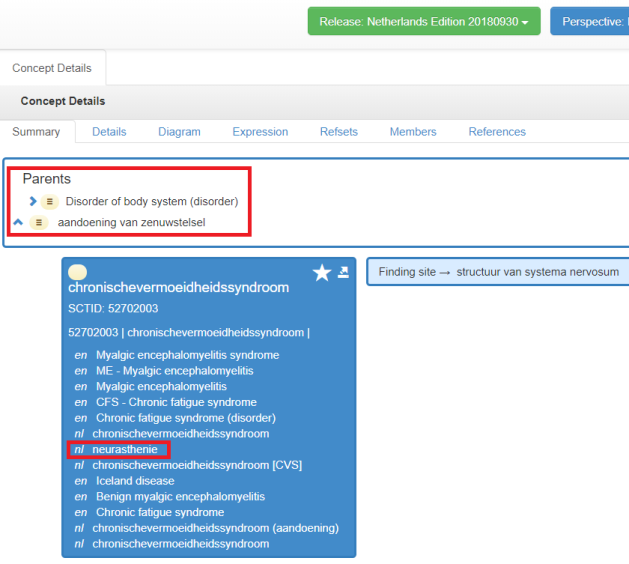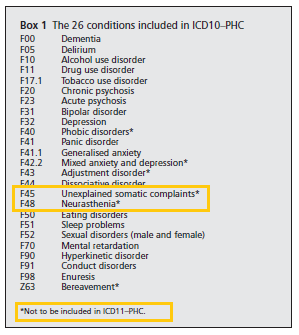December 28, 2015
by meagenda
Recent changes to SNOMED CT for CFS, ME and PVFS
- Correspondence between Forward-ME and UK Health and Social Care Information Centre
- SNOMED CT retires Mental disorder parent for Chronic fatigue syndrome and ME
- Projected changes to April 2016 release of Read Codes Clinical Terms Version 3 (CTV3)
- Read Codes system to be phased out as part of wider SNOMED CT implementation
In addition to ICD-10, a number of terminology and electronic health and medical record systems are used in the UK in primary, secondary, and health and social care clinical settings, which include:
OPCS-4 (classification of Surgical Operations and Procedures)
SNOMED CT (Systematized Nomenclature of Medicine – Clinical Terms, a comprehensive, multilingual clinical terminology system)
Read Codes (a coded thesaurus of clinical terms for recording patient findings and procedures in health and social care IT systems across primary and secondary care, e.g. GP surgeries and reporting of pathology results).
The National Information Board (NIB) has specified that all primary care systems adopt SNOMED CT by the end of December 2016 and that SNOMED CT is to be used as the single terminology in all health care settings in England, with a projected adoption date for the entire health system of April 2020 [3].
You can access a public SNOMED CT browser here: IHTSDO browser
This is an online browser and does not require any software to be downloaded. You will need to accept the license and then select for the UK “Local Extension” of SNOMED CT. Click on the “Search” tab to enter clinical terms.
The SNOMED CT International Edition and “Local Extensions” for a number of other countries, including the US, are also available via the browser. All editions release new updates twice a year, on a staggered schedule. The Release schedule for the UK Extension is April and October.
Read Codes system to be retired
The Read Codes system of clinical terms has been used in the NHS since 1985. As part of the adoption of SNOMED CT in primary care, Clinical Terms Version 3 (CTV3) is being deprecated.
More information on the phasing out of Read Codes, here:
Retirement of Read Version 2 and Clinical Terms Version 3
 Retirement Schedule
Retirement Schedule
There was no new release for CTV3 issued in October, but the April 2016 release is scheduled for Friday, 18th March 2016. The last release of CTV3 will be published in April 2018.
How have CFS and related terms been listed within SNOMED CT and CTV3?
SNOMED CT
Prior to July 2015, all editions of SNOMED CT had the following listings for CFS, ME and PVFS:
Chronic fatigue syndrome (with ME – Myalgic encephalomyelitis and several other related and historical terms listed under Synonyms) was assigned two parent disorder classes: Mental disorder, and Multisystem disorder.
Postviral fatigue syndrome was listed under Children to Chronic fatigue syndrome.
Read Codes (CTV3)
The twice yearly Read Codes releases (April and October) are available only to license holders but the codes can be viewed through this public resource (caveat: it is unclear how often this NCBO BioPortal ontology resource is updated with new releases for individual ontology systems):
See: BioPortal Xa01F
For CTV3, Xa01F Chronic fatigue syndrome (with ME – Myalgic encephalomyelitis and PVFS – Postviral fatigue syndrome under Synonyms) is listed, hierarchically, under two parent disorder classes: as a Sub Class of both Neurasthenia, under parent: Mental health disorder, and as a Sub Class of Neurological disorder.
See: http://purl.bioontology.org/ontology/RCD/Xa01F
Mental health disorder > Neurotic disorder > Somatoform disorder > Neurasthenia > Chronic fatigue syndrome
and
Neurological disorder > Chronic fatigue syndrome
See also the Visualization tab for a diagrammatic representation of dual parentage:
http://bioportal.bioontology.org/ontologies/RCD?p=classes&conceptid=Xa01F#visualization
Correspondence between Countess of Mar and UK Health and Social Care Information Centre
Forward-ME is an informal group for ME charities and voluntary organizations, chaired by the Countess of Mar, who also serves as Co-chair to the All-Party Parliamentary Group on Myalgic Encephalomyelitis (ME).
Between November 2014 and June 2015, Lady Mar was in correspondence with Mr Leon Liburd, Senior Support Analyst Systems and Service Delivery, and Ms Elaine Wooler, Advanced Clinical Terminology Specialist, UK Health and Social Care Information Centre.
Their correspondence (in reverse date order) was published on the Forward-ME website in June and can be read here Correspondence re SNOMED added June 2015
or open PDF here on Dx Revision Watch
 Correspondence re SNOMED
Correspondence re SNOMED
Changes to SNOMED CT
As a result of these exchanges, Lady Mar was advised that the relationship between the entry for 52702003 Chronic fatigue syndrome and the Mental disorder parent had been retired. In future editions, Chronic fatigue syndrome would be listed under the single parent, 281867008 Multisystem disorder.
See here
Additionally, 51771007 Postviral fatigue syndrome was being removed as a subtype of 52702003 Chronic fatigue syndrome (disorder) – though no rationale for this specific decision appears to be provided within the correspondence.
See here
[So 51771007 Postviral fatigue syndrome would be no longer be listed as a sub class under Children to 52702003 Chronic fatigue syndrome but directly under two parents: 281867008 Multisystem disorder and 123948009 Post-viral disorder.]
These changes were effected in the July 2015 release for the International Edition (Release 20150731).
They were subsequently incorporated into the September 2015 US Extension (Release 20150901), the October 2015 UK Extension (Release 20151001) and the November 2015 Swedish Extension (Release 20151130). It is expected that other country Extensions will also reflect these changes in their forthcoming releases.
Within the correspondence, on 11 November 2014, Mr Leon Liburd had also advised Lady Mar:
“It is also noted that the corresponding representation in the UK’s Clinical Terms Version 3 terminology product Xa01F | Chronic fatigue syndrome is classified as both a Neurological disorder and a Mental health disorder. As such, any conclusions emerging from the SNOMED CT discussions would also be reflected in the CTV3 UK product.”
Clarification re CFS and CTV3
In November, I contacted the UK Health and Social Care Information Centre for clarification of how CFS and its various Synonyms are currently listed within CTV3.
On 20 November, I was advised by Karim Nashar, Terminology Specialist, UK Terminology Centre, Health and Social Care Information Centre, that:
“[Xa01F | Chronic fatigue syndrome was being moved] under a single supertype 281867008 | Multisystem disorder (disorder) as to reflect the SNOMED correction in CTV3″
and that this change should be reflected in the April 2016 CTV3 release.
As noted above, Clinical Terms Version 3 (CTV3) is being deprecated and the last release of CTV3 will be published in April 2018.
The ICD-11 Beta draft and proposed classification of the G93.3 legacy terms
In June, WHO’s Dr Robert Jakob had told me that if TAG Neurology’s proposals and rationales for the G93.3 legacy terms were not ready for public release in September, he projected their release by December, latest (see towards end of Post #324).
No proposals were released in September and none in December. Eight years into the revision process and stakeholders still don’t know how ICD Revision proposes to classify the ICD-10 G93.3 legacy terms for ICD-11.
On 28 December, I called again, via the ICD-11 Beta Comments mechanism, for these terms to be restored to the public version of the Beta drafting platform.
References
1 UK Terminology Centre (UKTC): http://systems.hscic.gov.uk/data/uktc/
2 SNOMED CT: http://systems.hscic.gov.uk/data/uktc/snomed
3 NIB document ‘Personalised Health and Care 2020: A Framework for Action’:
https://www.gov.uk/government/publications/personalised-health-and-care-2020
4 IHTSDO browser: http://browser.ihtsdotools.org
5 Retirement of Read Version 2 and Clinical Terms Version 3: http://systems.hscic.gov.uk/data/uktc/readcodes
6 NCBO BioPortal Read Codes (CTV3) Xa01F Chronic fatigue syndrome
7 Forward-ME Correspondence re SNOMED added June 2015
Save





